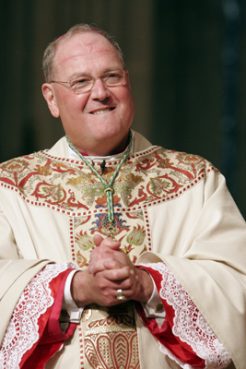
Archbishop Timothy M. Dolan smiles at his Mass of Installation as head of the Roman Catholic Archdiocese of New York at St. Patrick’s Cathedral in New York April 15 2009.
VATICAN CITY — In a ceremony in St. Peter’s Basilica on Monday (June 29), Pope Benedict XVI placed a thin strip of white lamb’s wool around the necks of 34 recently appointed archbishops from around the world, including five from the United States.
The band of wool, known as a “pallium,” symbolizes the responsibilities that come with overseeing some of the Catholic Church’s largest flocks. The pallium ceremony is also a reminder of the challenges and opportunities that await the men back in their newly assigned archdioceses.
Yet for Archbishop Timothy Dolan of New York, the trip to Rome was not only an occasion for looking ahead, but also a homecoming of sorts.
For four years in the 1970s, Dolan studied for the priesthood here at the Pontifical North American College (PNAC), the elite training ground of U.S. priests that has produced a number of the nation’s living bishops.
From 1994 through 2001, Dolan was the seminary’s rector, a job whose occupants have traditionally gone on to higher things. On the day before the pallium ceremony in St. Peter’s, Dolan returned to the college on Rome’s Janiculum Hill to celebrate Sunday Mass.
“I never want to be in Rome without offering Mass in that chapel,” Dolan said. Visiting his old stomping grounds “renews everything the priesthood is all about,” by recalling the “desire for integrity and holiness, learning and apostolic fervor” of the more than 200 men he oversaw at “the NAC.”
The pallium ceremony took place only 10 days after Benedict inaugurated the Year for Priests, an effort to encourage the world’s 400,000 Catholic clergy in what the pontiff called their “striving for spiritual perfection.”
Considering the state of the American clergy — decades of dwindling ranks and, more recently, the sexual abuse scandal — Dolan pointed to the need to rediscover the call to the priesthood as something far deeper than a mere job description.
“If we only look at our priesthood as a career … sooner or later we’re going to get fatigued and frustrated,” said Dolan, who was installed as the leader of the nation’s second-largest diocese on April 15.
“If we know that at our core the priesthood is who we are, well then, that animates and inspires and gives us the fidelity and generosity that we need.”
U.S. priests may have a particular need to learn this lesson because “America by its nature is very utilitarian and pragmatic,” Dolan said. Success, he cautioned, can’t simply be evaluated in terms of congregation size or other quantitative measures.
The affable and informal archbishop, relaxing in shirtsleeves and loosened Roman collar during a break during his official pallium-week events, sipped a Heineken and puffed on a Macanudo cigar as he fielded a reporter’s questions, apparently unfazed by even the most sensitive topics.
The sexual abuse crisis is “actually leading to a gradual renewal of the priesthood,” Dolan insisted; instead of demoralizing seminarians and young clergy, he said, the scandals have “purified their intentions and led to an inner resolve that the integrity of their priestly life would be impeccable.”
A controversial 2005 Vatican document that forbids seminaries to accept men with “deep-seated homosexual tendencies” is an example of the “refreshing rigor that we have recovered in our priestly formation” since the reign of Pope John Paul II, Dolan said.
Yet he maintained that the mere presence of “same-sex attraction” need not disqualify men from the priesthood, as long as they do not make that attraction the basis of their identity, have a “background of unchaste living, whether hetero or homo,” or dispute the church’s teachings on sexuality.
That question has gained new currency since Archbishop Rembert Weakland, Dolan’s predecessor in his previous post as archbishop of Milwaukee, declared his own homosexuality in an autobiography published in June, and called on the church to rethink its condemnation of homosexual acts.
Declining to comment on Weakland’s book, which he said he had not read, Dolan insisted that the “church’s tradition on sexuality is something we can’t change, because we get it from the Lord,” but he acknowledged a need to present that teaching in a “more credible, cogent way.”
Dolan’s stance on this issue reflects the style he established as rector of the NAC: a tendency to invoke expectations rather than rules, stress inspiration over threats of punishment, and consider opposing points of view without compromising on his own convictions.
“He would focus on the good on both sides, see the virtue in both perspectives, and then make it all into an integrated whole,” said the Rev. Roger Landry, a priest in New Bedford, Mass., who studied under Dolan at the NAC.
(OPTIONAL TRIM FOLLOWS)
Dolan took the same firm yet conciliatory approach to the recent controversy surrounding the University of Notre Dame’s decision to award an honorary degree to President Barack Obama.
Dolan was one of about 80 U.S. bishops who publicly criticized the Catholic institution’s action, which he called a “big mistake,” because of Obama’s support for legalized abortion and embryonic stem cell research.
Yet Dolan recognized the “need to give (Obama) his due.” The president, he said, “has inspired a sense of hope. He does seem to be tackling problems such as healthcare and the economy with a vigor that we find laudable, and he does seem to have a refreshing view on issues of international concern.”




